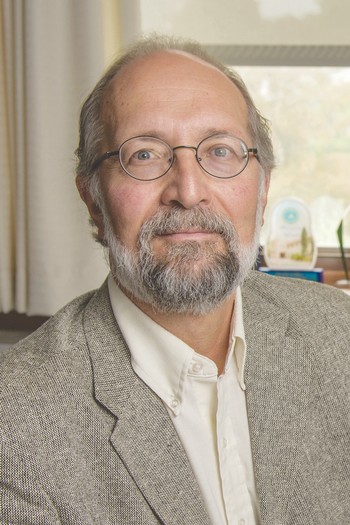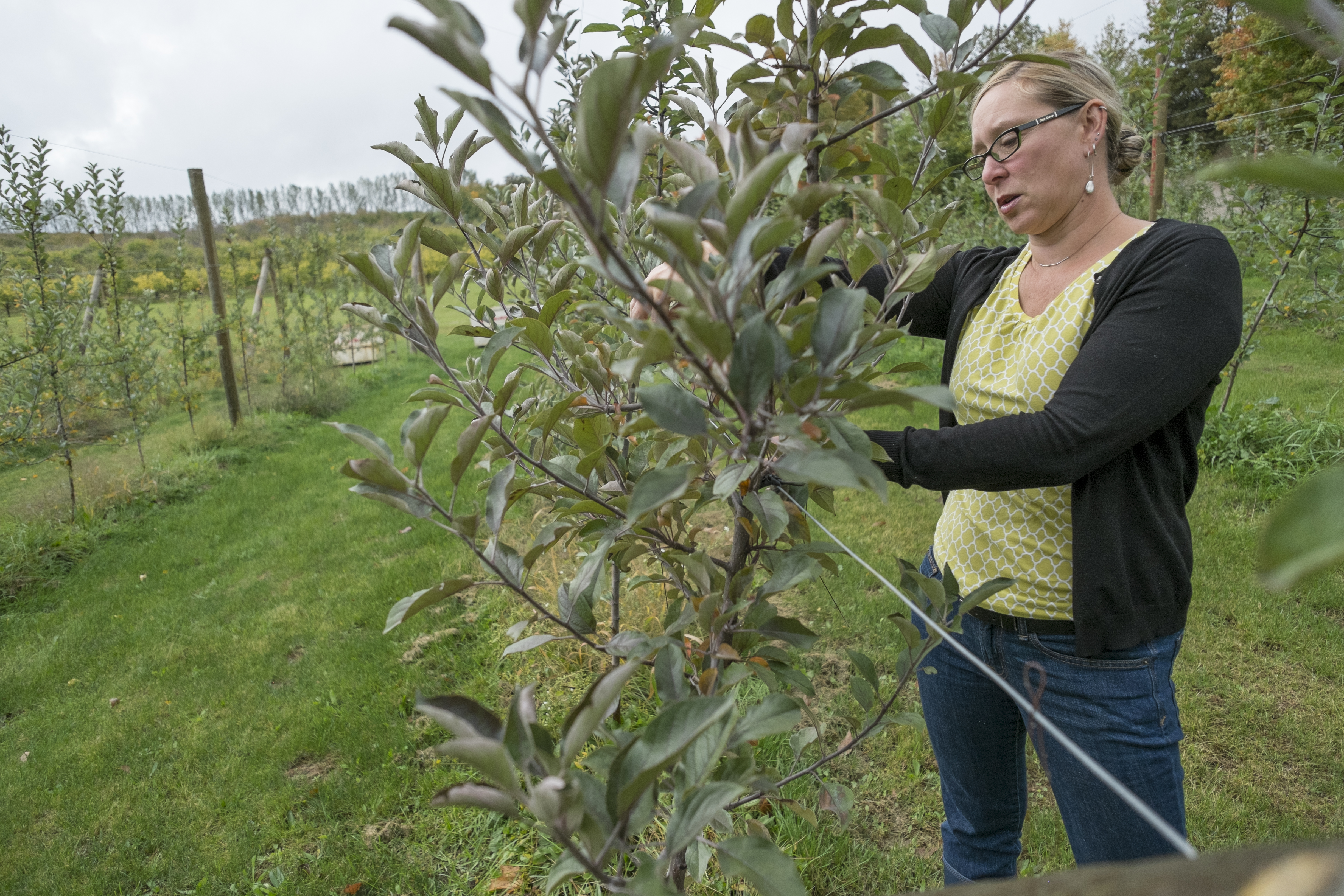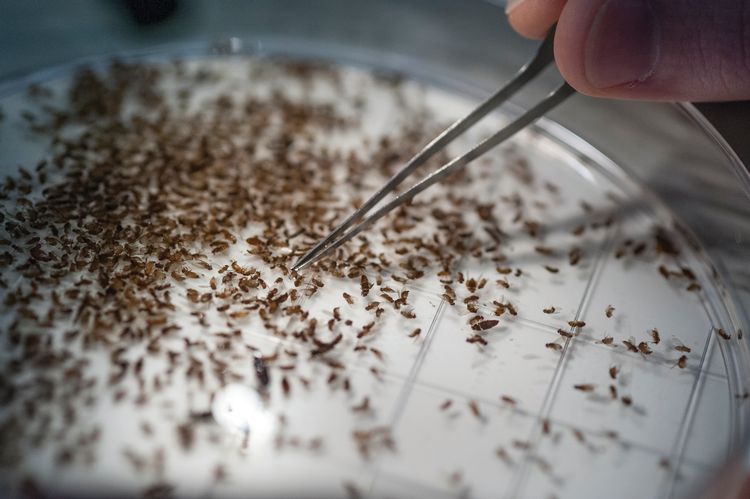A fruitful partnership
MSU, Tree Fruit Commission, MDARD partner to support fruit industry

Since 2014, the Michigan Tree Fruit Commission – a unique partnership among Michigan’s tree fruit industry, MSU AgBioResearch, MSU Extension and the Michigan Department of Agriculture and Rural Development – has been instrumental in supporting Michigan State University tree fruit research and outreach through donations and strategic planning.
The collaboration allows for the state’s apple, cherry, peach and plum growers to work side-by-side with researchers to address critical infrastructure needs at the university’s five MSU AgBioResearch Centers dedicated to tree fruit research. Endeavors support MSU researchers and Extension educators and specialists to enhance their capabilities to respond to ever-changing needs.
Jim Nugent, chair of the Tree Fruit Commission and a cherry grower from Suttons Bay, Michigan, said the partnership is essential in supporting applicable research and supplying information to growers.
“The Tree Fruit Commission is proud of what we’ve been able to accomplish and the partnerships we’ve built,” said Nugent, who joined MSU Extension in 1976 as the Leelanau County MSU Extension Director and served as a district horticulturalist and coordinator of the Northwest Michigan Horticultural Research Station from 1992 until his retirement in 2007.
“Upon establishing the commission, we felt it was critical to the future of the industry that we maintain a strong research arm connected to MSU, and we decided that it was going to be in everybody's best interest if we could come up with a partnership that allows the industry to work more closely with the university.
“This partnership speaks highly of the tree fruit industry for seeing a need for this commission and having the willingness to fund it. Everyone involved has the same desire, to make the tree fruit industry better, more profitable and more sustainable, and we have a great appreciation for the role that the university plays through its research and delivery of information to the farming community. I know as a grower, I rely on that information a great deal.”
Inception
The Michigan Tree Fruit Commission was established with the following objectives:
- Address the need to improve the infrastructure at the MSU fruit research centers: Clarksville Research Center, Northwest Michigan Horticulture Research Center, Southwest Michigan Research and Extension Center, and Trevor Nichols Research Center. It also includes facilities at the new West Central Michigan Research and Extension Center, located in Hart, MI.
- Assure that researchers are ready and equipped to address the industry’s pressing issues.
- Enhance the capabilities of the MSU Extension fruit team to keep the industry on the cutting edge of information and technology.
“The Tree Fruit Commission did something unique, in that we brought together four different fruit commodities and merged them all into one organization,” Nugent said. “That had not been done previously under Public Act 232. I think the cooperation between the commodity groups and all our other partners was crucial. That really close connection between the growers and the researchers has been there since day one. It really helps the researchers stay tightly connected to what's important to the industry, and it helps the industry stay tightly connected to what the researchers are working on. I don't know of any other way to be really successful.”
Cooperation and support allows MSU AgBioResearch, which operates the research centers, to produce practical, and applicable research to benefit fruit production.

“What we have in Michigan is unique,” said Doug Buhler, Director of MSU AgBioResearch and MSU Assistant Vice President of Research & Innovation. “We’ve had all our partners come together in a way that allows us to pool our resources and do things that none of us could do by ourselves.”
Buhler credits commodity funding from Project GREEEN, the Tree Fruit Commission as well as base funding from the state and federal governments for “coming together to make us competitive, do our work and be among the best in the country in terms of our support of the industry.”
“The Tree Fruit Commission has been instrumental in helping us bring much of our equipment and infrastructure up to date at the research centers,” Buhler said. “I look at how well we have done in recent years competing for funds through the USDA Specialty Crop Research Initiative. We've had a couple of really good years in the SCRI, and I believe that the facilities the Tree Fruit Commission has helped us maintain and improve are absolutely critical to being able to attract that type of national support.”
Supporting research centers
Nikki Rothwell joined the staff of the Northwest Michigan Horticultural Research Center (NWMHRC) in September 2004 as the District Integrated Pest Management Agent for Fruit. She was since named NWMHRC Faculty Coordinator and remains an MSU Extension Specialist.
During her more than 15 years at NWMHRC, Rothwell has worked to produce applicable research for Michigan’s growers, while receiving research funding from the Tree Fruit Commission.

“I think all of us at MSU feel fortunate that the industry continues to support the research we do. I also think it is a two-way street. It is important for us to do research that impacts Michigan fruit farming, and these funds have helped keep us focused on issues that are important to the growers,” said Rothwell, whose commission-supported research includes work on Spotted Wing Drosophila (SWD) and fire blight.
“There are other universities out there that conduct fruit research, but the closer to home Michigan’s growers can get information and Michigan-based recommendations, the more likely the research is going to work on Michigan farms.”
Tree Fruit Commission support has enabled the addition of six new orchard blocks at NWMHRC for research on:
- High-density apple fields used to examine berming trees that are grown in sandy soils;
- High density sweet cherries that explore the potential to grow modern systems to increase revenue compared to traditional systems;
- A new orchard to study fire blight research (George Sundin, University Distinguished Professor and Extension Specialist, and Rothwell received a $5.2 million SCRI grant for this project)
- Two general purpose tart cherry orchards.
The commission has also pledged to fund a laboratory expansion to support various projects, including pivotal SWD research. The lab expansion, slated to be completed in fall 2021, will help NWMHRC further its year-round research, as well as host more graduate students and visiting faculty.

“We really needed the lab upgrade, especially with the development of issues the tree fruit industry faces with Spotted Wing Drosophila,” Nugent said. “There's certainly a lot of critical work that’s needed in pest control, but a real driver since the Tree Fruit Commission was founded has been the introduction of SWD. It's just a game changer like nothing else in my lifetime. It's hard to overstate the significance of this pest, and the importance of the work that MSU is doing on this issue.”
Infrastructure upgrades have allowed researchers at the center to complete new research and outreach projects.
“We have great new information on training systems for high-density sweet cherries. We are working with an ag economist to put some numbers to our horticultural findings, which will be exciting for growers. We have also expanded apple research on many fronts here at the NWMHRC. We have typically been known as the cherry station, but as more growers put in high-density apples, we have conducted many plant growth regulator and fire blight trials to help growers adopt these modern systems,” Rothwell said.
As District Extension Horticultural Educator, Rothwell provides leadership and coordination that helps maintain the flow of current research-based and management information to the fruit industry. She also helps to improve the skills of growers and agribusiness persons in application of research results to their particular production or marketing situation and works with the northern Michigan fruit industry to provide horticultural leadership in the regions.
“The MTFC has been critical to the success of the NWMHRC. The intent of this group was to support infrastructure at the beginning, and this was crucial for our station. It really allowed us to stop thinking about band-aid approaches to managing and executing research trials to thinking more broadly and bigger. Personally, these funds have helped me focus on conducting research rather than finding every cent to initiate a research trial,” Rothwell said.
The commission has supported similar and comparable upgrades and research at MSU’s four other tree fruit research centers and each has helped produce valuable resources for the state’s growers. The Tree Fruit Commission also helped support the opening of the new MSU AgBioResearch center in Hart, which will be used to study apples, cherries and peaches, as well as vegetables like asparagus.
“Our industry isn't big enough to do this on our own,” Nugent said. “Likewise, the university benefits a great deal from the support of the industry. The commission’s support is real in terms of dollars, but also providing a strong partner to help the university tell the story of the impact of this research to our legislators and other stakeholders. It’s really a crucial partnership.”
The Commission is funded through grower contributions based on production and matching funds from the State of Michigan. Efforts are shared among organizations that support the fruit industry, including the Michigan Apple Committee, the Cherry Marketing Institute, Michigan Farm Bureau, the Michigan Agricultural Cooperative Marketing Association and the Michigan State Horticulture Society.
It was established under Michigan Public Act 232, which relates to the marketing of agricultural commodities to provide for marketing and research programs, agreements, referendums by producers, assessments on producers, and commodity committees.



 Print
Print Email
Email





